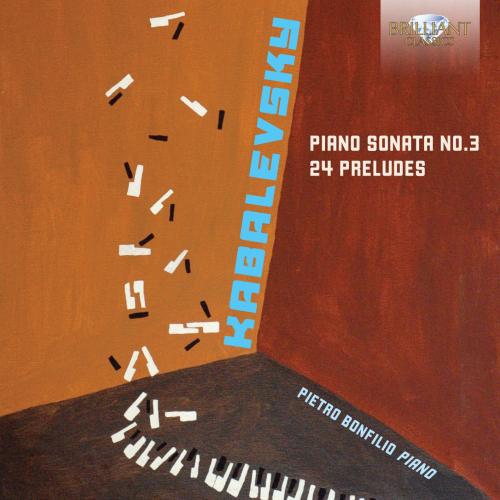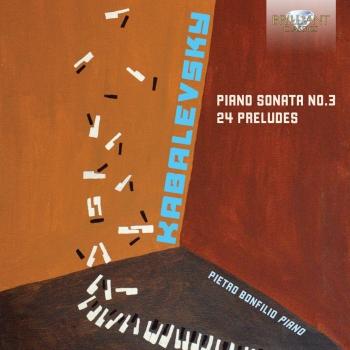
Kabalevsky: Piano Sonata No.3, 24 Preludes Pietro Bonfilio
Album Info
Album Veröffentlichung:
2017
HRA-Veröffentlichung:
26.05.2017
Label: Brilliant Classics
Genre: Instrumental
Subgenre: Piano
Interpret: Pietro Bonfilio
Komponist: Dmitri Borisovich Kabalevsky (1904-1987)
Das Album enthält Albumcover Booklet (PDF)
- Dmitri Borisovich Kabalevsky (1904 - 1987): Piano Sonata No. 3 in F Major, Op. 46:
- 1 I. Allegro con moto 05:42
- 2 II. Andante cantabile 05:14
- 3 III. Allegro giocoso 04:54
- 24 Preludes, Op. 38:
- 4 I. Andantino in C Major 01:34
- 5 II. Scherzando in A Minor 00:42
- 6 III. Vivace leggiero in G Major 01:32
- 7 IV. Andantino in E Minor 02:14
- 8 V. Andante sostenuto in D Major 02:27
- 9 VI. Allegro molto in B Minor 01:19
- 10 VII. Moderato e tranquillo in A Major 02:27
- 11 VIII. Andante non troppo. Semplice e cantando -Poco Agitato - Tempo I in F-Sharp Minor 02:08
- 12 IX. Allegretto scherzando -Poco più mosso in E Major 01:44
- 13 X. Non troppo allegro ma agitato. Recitando, rubato - Largo -Come prima - Largo in C-Sharp Minor 04:02
- 14 XI. Vivace scherzando in B Major 00:52
- 15 XII. Adagio in G-Sharp Minor 02:50
- 16 XIII. Allegro non troppo in F-Sharp Major 02:33
- 17 XIV. Prestissimo possibile in E-Flat Minor 02:18
- 18 XV. Allegretto marcato in D-Flat Major 00:52
- 19 XVI. Allegro tenebroso in B-Flat Minor 01:41
- 20 XVII. Andantino tranquillo in A-Flat Major 02:06
- 21 XVIII. Largamente con gravita in F Minor 01:33
- 22 IXX. Allegretto in E-Flat Major 01:00
- 23 XX. Andantino semplice in C Minor 02:47
- 24 XXI. Festivamente. Non troppo allegro in B-Flat Major 02:09
- 25 XXII. Scherzando. Non troppo allegro in G Minor 02:03
- 26 XXIII. Andante sostenuto in F Major 02:07
- 27 XXIV. Allegro feroce - Meno mosso. Marciale. - Pochissimo più mosso - Poco meno mosso in D Minor 04:11
Info zu Kabalevsky: Piano Sonata No.3, 24 Preludes
Once considered in the same breath as Prokofiev and Shostakovich, Kabalevsky’s star has waned somewhat (the same fate has befallen both Myaskovsky and Khachaturian), both in his native Russia and farther West, where he is primarily remembered for his exuberant orchestral potboiler, the overture he wrote to an opera on a Romain Rolland story, Colas Breugnon. The opera won both a Lenin Prize and Rolland’s approval – no small feat – but has been completely forgotten. However, the offbeat rhythms that made the overture an instant hit also lend an upbeat, funky character to the opening movement of the Third Piano Sonata.
Kabalevsky wrote the sonata in 1948, shortly after the premiere of another opera, Taras and his Family, based on the same gory narrative which inspired Janáček’s orchestral fantasy, Taras Bulba. ‘Excellent music (much Prokofiev),’ wrote Myaskovsky in his diary, ‘but the libretto is dreadful.’ The composer may have taken note, for although the opera was not revived, he used several of its themes in the sonata. Sweet playfulness and calm characterize the first theme, the gliding movement of the waltz in the second, and a spirit of youthful fanfare in the finale.
The 24 Preludes were composed in 1943 and dedicated to Myaskovsky. Kabalevsky had lately (like Shostakovich) been in siege-ridden Leningrad, and the wartime mood may have contributed to the patriotic flavour of the Preludes: each one uses a theme from folk-music collections of Rimsky-Korsakov, Balakirev and Liadov. Their first performer was the Russian virtuoso Yakov Flier, who was sufficiently convinced of their merits to include them in his international tours. ‘They are not mere transcriptions of the songs’, he declared, ‘but new, original works of great cohesion, a cycle in which each part has a meaning of its own. Each Prelude expresses a particular mood and significance… It is one of Kabalevsky’s most profound and successful works.’
Compared to works of political expediency such as the Song of the Party Membership Card from 1956, Flier was doubtless right.
During his lifetime Dmitri Kabalevsky (1904-1987) was considered by the authorities to be one of the Top 5 composers of Russia, on a par with Prokofiev and Shostakovich. He was praised for his formalism, general popular style and patriotism. He was not a revolutionary, and this caused his fame to decline after the collapse of the Soviet Union. His music however has a strong identity, vigorous, alternating power with lyricism, and rooted in the rich folklore of Russia.
This new recording contains his effervescent 3rd Piano Sonata and the complete 24 Preludes Op. 38, written during World War II, each based on a Russian folk song, presenting a wide variety of moods, from the pensive melancholy to fiery passion.
Played by the highly talented young Italian pianist Pietro Bonfilio, who expresses his love for the Russian culture with this beautiful recording.
Pietro Bonfilio, piano
Pietro Bonfilio
Born in Tuscany (Italy) in 1990 graduated with honors at “Conservatorio Giuseppe Verdi” in Milan under the guidance of M° Vincenzo Balzani. He completed a Master’s degree in performance with Distinction at the Royal Conservatoire of Scotland under the guidance of M° Victor Sangiorgio. He attended Masterclass with Paolo Bordoni, Ian Fountain, Jean ‐Marc Luisada, Giuseppe Andaloro and Lang Lang.
He performed in the USA (Carnegie Hall in New York, NYU and Cornell University in Ithaca), in various cities of Sweden, Scotland (Stevenson Hall and in the Royal Concert Hall of Glasgow), Mexico (Centro Cultural Bicentenario in Mexico City), Cambodia (Phnom Penh Piano Festival Meta House), Thailand (Bangkok Piano Festival, Siam Ratchada Auditorium).
He has performed frequently in Milan, most notably at Teatro alla Scala, in the Salone Napoleonico of Palazzo Serbelloni, in the Royal Palace, in the Puccini hall and in the Verdi hall, in the great hall of Casa Verdi, in Villa Litta Borromeo Visconti for Società Umanitaria, in the Gaber Hall for the Società dei Concerti.
He has played in various Italian cities and for various musical istitutions, in particular for the Fondazione Toscana Spettacoli, in the Salone dei Cinquecento of Palazzo Vecchio in Florence, at the IX edition of the International Festival C.I.M.A. in Tuscany, at Palazzo Albrizzi in Venice.
He performed as a soloist with Mexico State Symphony Orchestra, with Philharmonic Orchestra “Mihail Jora” Bacau, with Grosseto Symphony Orchestra, and with Reggio Calabria “Francesco Cilea” Orchestra.
He won several competitions such as: XXV Ibla Grand Prize, XII edition of the International competition Monterosa Kaway, XX edition of the competition Riviera della Versilia held in Viareggio, II edition of the competition Agimus held in Florence, XI edition of the national competition Riviera Etrusca held in Livorno, V edition of the competition Lissonum Young Performers held in Milan, IX edition of the International competition New Horizons held in Arezzo.
Awarded the scholarship by the International Association of Richard Wagner for Bayreuth Festival 2014.
Corriere della Sera, La Repubblica, La Nazione, Il Tirreno and Suonare News have given him glowing reviews and RAI TV News (TG1) have interviewed him, introducing him as “A promising young talent on the Italian, musical scene.” In 2011 he recorded a concert for the national service Radio Classica, as guest artist on their programme The Pianist. In 2014 he played live for RadioRai3.
Since 2012 is the artistic director of Morellino Classica Festival in Tuscany. (www.morellinoclassicafestival.com)
He recorded a CD for Brilliant Classics dedicated to the Russian composer Dimitri Kabalevsky.
Booklet für Kabalevsky: Piano Sonata No.3, 24 Preludes










